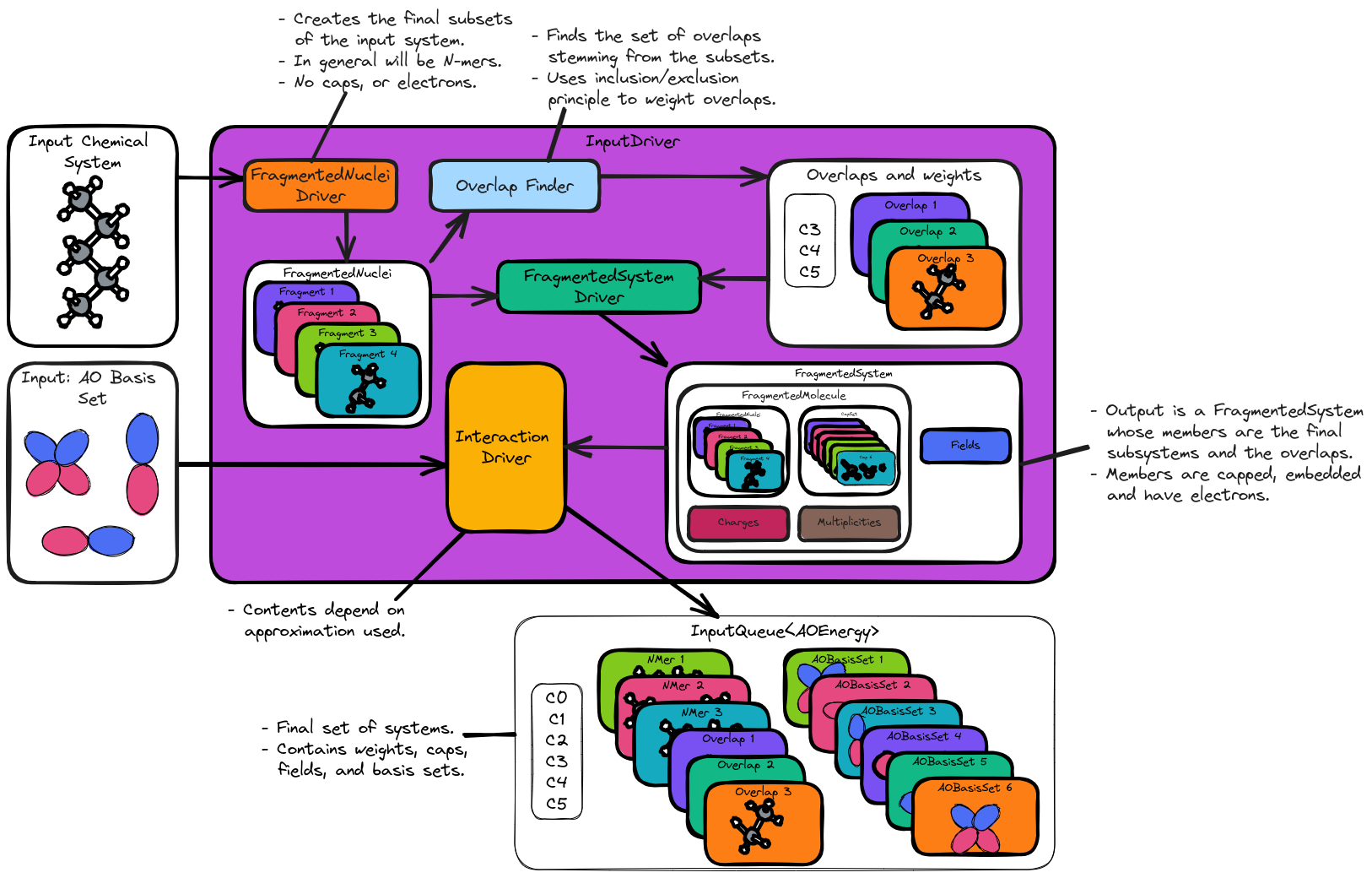Designing GhostFragment’s Input Driver
What is the Input Driver?
GhostFragment Design Overview separated GhostFragment into two components: the input driver and the engine. The input driver is tasked with going from the system we actually care about to the inputs needed to approximate that system.
Input Driver Considerations
- Accuracy
GhostFragment Design Overview delegated the accuracy consideration to the input driver. At this level accuracy primarily entails:
Ensuring that the final set of sub-systems contains all important interactions, e.g., all important \(n`\)-mers are present.
Being able to correct for BSSE.
- Supersystem property type
GhostFragment Design Overview mentioned that the module implementing the fragment-based method should satisfy the same property type as the module it is approximating. If the input driver is to be the first contact with the user’s input, we can skip a pre-processing step by having the input driver’s API be a subset of the target property type’s inputs.
We assume that we are approximating something that takes a
ChemicalSystemand anAOBasisSet.
- Overlap
We assume that the sub-systems we are working with are non-disjoint. It is necessary to determine the overlaps of the sub-systems and correct for them.
When taking overlaps, we need to consider caps too. A cap overlaps with the atom(s) it replaces.
- Opaque fragmentation
At the level of the input driver we assume that a submodule prepares the final set of fragments and the input driver can be agnostic to how the fragments were formed other than that they may overlap (consideration Overlap).
- Inclusion exclusion principle
Somewhat of a corallary of Opaque fragmentation, we assume that the inclusion-exclusion principle can be used to determine the coefficients of the fragments.
This allows us to decouple how the fragments are formed, from the energy equation.
Input Driver Design

Fig. 4 The architecture of the input driver component.
Fig. 4 shows the high-level design of the input driver.
Following from consideration Supersystem property type the inputs to the driver
match those of the module it’s meant to be approximating (here it’s assumed to
be AOEnergy, but a similar idea holds for gradients or frequencies). Inside
the input driver we decompose the process of preparing the sub-calculation
inputs into several steps.
The first step is the creation of the fragments, which is handled by the
FragmentedNuclei driver. It is worth noting, that here we use the term
fragment loosely since the outputs could be actual fragments or \(n`\)-mers. A
more detailed discussion of the FragmentedNuclei driver is deferred to
Designing GhostFragment’s FragmentedNuclei Driver.
Once we have the fragments, we need to find the overlaps, and in the process we also obtain the weights for the overlaps.
Next, the fragments and the overlaps are turned into a FragmentedSystem
object (the inputs needed for running a calculation). With the final set of
sysetms established, the InteractionDriver pairs each fragment with its
corresponding basis set, creating the final set of inputs.
A full discussion of the “Fragmented System Driver” is derferred to
Designing GhostFragment’s FragmentedSystem Driver. For now we note, the Fragmented
System Driver is responsible for taking an input set of FragmentedNuclei
and a ChemicalSystem and creating the final set of sub-systems to use. These
sub-systems are returned as a FragmentedMoleculeSystem object and do NOT
include the overlaps (as dictated by consideration Overlap). Forming
of \(n`\)-mers will happen in the fragmented system driver and thus satisfying
consideration Accuracy will be partially addressed here.
The exact contents of the “Interaction Driver” will depend on the approximation being used. If the user wants the traditional (G)MBE, the input will be the set of n-mers which survived the screening process and the module will be responsible for working out the overlaps (including their weights), capping the overlaps, and assigning AOs to each \(n`\)-mer and overlap. If the user instead wants a BSSE-corrected interaction, then assigning the AOs becomes more complicated. A full discussion of the Interaction driver is beyond our current scope.